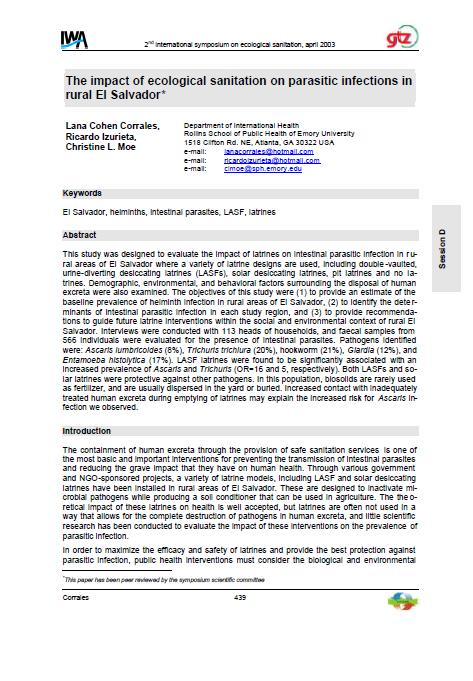The impact of ecological sanitation on parasitic infections in rural El Salvador
Corrales, L.C., Izurieta, R., Moe, C.L. (2003)

Published in: 2003
Author:
Corrales, L.C., Izurieta, R., Moe, C.L.
Uploaded by:
SuSanA secretariat
Partner profile:
common upload
4378 Views
25 Downloads
Content - Summary
This study was designed to evaluate the impact of latrines on intestinal parasitic infection in rural areas of El Salvador where a variety of latrine designs are used, including double-vaulted, urine-diverting desiccating latrines (LASFs), solar desiccating latrines, pit latrines and no latrines. Demographic, environmental, and behavioral factors surrounding the disposal of human excreta were also examined. The objectives of this study were (1) to provide an estimate of the baseline prevalence of helminth infection in rural areas of El Salvador, (2) to identify the determinants of intestinal parasitic infection in each study region, and (3) to provide recommendations to guide future latrine interventions within the social and environmental context of rural El Salvador. Interviews were conducted with 113 heads of households, and faecal samples from 566 individuals were evaluated for the presence of intestinal parasites. Pathogens identified were: Ascaris lumbricoides (8%), Trichuris trichiura (20%), hookworm (21%), Giardia (12%), and Entamoeba histolytica (17%). LASF latrines were found to be significantly associated with an increased prevalence of Ascaris and Trichuris (OR=16 and 5, respectively). Both LASFs and solar latrines were protective against other pathogens. In this population, biosolids are rarely used as fertiliser, and are usually dispersed in the yard or buried. Increased contact with inadequately treated human excreta during emptying of latrines may explain the increased risk for Ascaris infection we observed.
Additional information
Paper presented at "2nd International Symposium on Ecological Sanitation", April 2003, IWA and GTZ
Bibliographic information
Corrales, L.C., Izurieta, R., Moe, C.L. (2003). The impact of ecological sanitation on parasitic infections in rural El Salvador.
Filter tags
English Latin America & Caribbean Rural














